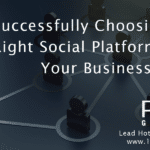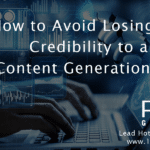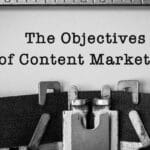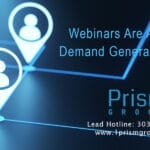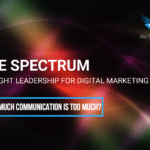If you asked me two years ago who our top clients would be today, I would have guessed very wrong! Many of our most active clients provide technology-based solutions that improve the environmental performance of heavy industry, which speaks to how quickly markets have changed. Only a few years ago, this was not the case.
The investment community, regulators and other key stakeholders have elevated Environmental, Social and Governance or “ESG” concerns to the same level as traditional financial metrics carving out a specific need for ESG Marketing.
On a larger scale, the culture has changed, providing new opportunities for innovative companies that not only make money, but also lighten humanity’s load on the planet.
In the Energy business in particular, oil and gas producers traditionally used quantitative capital budgeting models to force rank projects and alternatives. If the Net Present Value of a particular solution generated one more dollar than an alternative that might be better for the environment, many “rational” executives would opt for the extra dollar even though it meant generating more emissions of substances believed to be driving climate change.
Today, the definition of “rational” has expanded to include not just financial criteria, but also the environmental and social impacts of business operations. That is not necessary a bad thing!
Green Doesn’t Sell Sells
So, what changed? Today, businesses are being pressured by investors, regulators, communities and other key stakeholders to improve their environmental performance, which is the “E” in ESG. Quite simply, the culture changed.
In fact, the SEC is currently developing new rules for how public companies disclose climate risks in regulatory filings with the agency. We are already seeing potential acquirors of oil and gas assets performing extensive environmental due diligence to better understand risks associated with buying oil and gas assets.
Green, it seems, has become an important factor in B2B buying processes.
That is a 180-degree turnaround from only three years ago when it was routine to tell a client that “green doesn’t sell” when crafting their marketing communications, unless of course green is the color of money. Back then we had to focus on the economic, operational and safety benefits, because an environmental message was actually counterproductive when pitching environmental services!
In a case of the more things change the more they remain the same, although companies can now lead with a green message, they still have to do their math homework and be prepared with economic analyses to bolster their value proposition.
What’s Working and Tips for Success
Yes, you can save the planet and make money (multi-factor value proposition). In our view, the ESG solutions that will be the stickiest and most successful in the long run are those that offer both improvements in both environmental and financial performance. It is not enough to simply reduce emissions from a well site, for example, the solution must offer tangible increases in profitability and/or reductions in cost. Compliance-oriented value propositions will find it difficult to compete with the one-two punch of solutions that create cleaner operations that make more money. Corporate boards and decision makers can hold two thoughts in their heads at the same time and the solutions that positively move the needle on both factors will be the biggest winners.
Pivot to the niche where you have natural competitive advantages instead of trying to compete against everyone all the time.
Positioning and pivoting – find your niche. When you have a hammer, every problem looks like a nail. During the ealry stages of market development, it is helpful to recognize that your solution may not necessarily be the answer to every similar problem. Some technologies are going to fit different niches better than others, and that is the key to growing fast – know how to position your solution relative to others and pivot to the niche where it has the best fit and greatest impact on customer results. Pivot to the niche where you have natural competitive advantages instead of trying to compete against everyone all the time. Trying to do it all from the start is a surefire recipe for stretching your resources too thin and wasting capital.
Example: In the market for methane monitoring, industry has several alternatives including satellite, aircraft, drones, laser networks, fence line monitoring and optical imaging. Each technology has its own strengths and weaknesses. For example, satellites are good for monitoring inaccessible areas (think Russia or China), while fence line monitoring is well-suited for individual locations (e.g., an individual well site, production facility or tank battery, etc.)
Avoid confusing early success with a real market. Remembering the Technology Adoption Lifecycle, many ESG buyers fall into the Innovator or Early Adopter categories. Acquiring your first two or three customers does not necessarily imply that you have uncovered a significant market opportunity; it just might mean that you now have 100% market share of a very small market!
In other words, it may take longer than anticipated to cross the “chasm” from the Early Adopter segment at the front end of the lifecycle to the large Early Majority. That matters because both audiences have different psychologies and information needs.
When it comes to ESG, especially in the Energy industry, bigger companies are adopting environmental performance solutions faster than smaller ones.
The Early Majority looks different for ESG. In most situations, larger companies tend to follow the leads of smaller, more innovative competitors. When it comes to environmental performance, especially in the Energy industry, bigger companies are adopting solutions faster than smaller ones. That is because large, publicly traded companies are exposed to institutional investors and activists who are pressuring the industry to reduce its impact on climate change. And, they typically have the financial resources to adopt new technologies in a capital constrained environment. It is not a secret that some of the super majors, Integrated producers and National Oil Companies are the ones most aggressive in pushing to eliminate routine flaring and achieve net zero emissions.
Jockeying for position – it’s still early in the race. Not only are the Early Adopters of larger size in the Energy sector when it comes to environmental performance, but they are also evaluating multiple technologies simultaneously to see which ones stick. As one technology screener at a major oil and gas company put it – “We want to move up the experience curve quickly. We want to apply a technology to many well sites and either fail very fast or find the solutions that can move the needle for a company our size.”
Example: In May 2021, Chesapeake Energy announced a pilot project with Project Canary to certify natural gas produced from certain well sites as “Responsibly Sourced Gas” or RSG. Only months later in July, Chesapeake announced a similar RSG pilot project with Methane Intelligence (MiQ) to certify gas produced from the Appalachian region. Clearly, Chesapeake is seeing which RSG solution offers the best value and becomes accepted among RSG buyers. This is a classic sign of being early in the Lifecycle, in preparation for the Early Majority choosing the de-facto standards for the rest of the market.
Build a Vision through Thought Leadership. The marketing communications imperative for companies selling innovative and disruptive technologies is building a vision in the minds of buyers. That vision must be enormously compelling, solve a big problem and/or otherwise move the needle in a significant way. A marginal reduction in operating costs isn’t going to persuade an internal champion to pull you through the gauntlet of a corporate buying cycle. Building that vision relies on establishing yourself as an acknowledged Thought Leader.
Content Marketing. If Thought Leadership is the goal, then content marketing is the strategy for achieving it. Compelling case studies, use cases demonstrating practical applications, concise messaging, audience targeting, webinars, public speaking engagements, executive videos and other content that educates and informs the market is essential to building Thought Leadership. Earned media can certainly play a positive role, but ultimately your reputation will be built on the successes of your customers, as evidenced in case studies and coveted testimonials.
Why It Matters
Here is our take on the implications for ESG marketers.
- Understanding the unique challenges of selling environmental performance solutions are essential to overcoming the hurdles and positioning your company as a winner.
- Knowing where you are in the Technology Adoption Lifecycle provides critical insight on what strategies to employ to build your early customer base.
- Take time to build a multi-factor value proposition that includes both environmental performance and economic benefits. A compliance-only solution is a tougher sell.
- Selling a bunch of pilot projects doesn’t necessarily mean you are the market leader, you are still in the early stages of the race! Keep your foot on the gas pedal to increase market share.
- Build both effort and budget into your marketing plan for developing content marketing assets. These are not trivial to develop, and they are essential to your success.
Let’s Talk! Schedule a free 30-minute Digital Marketing consultation to see if there is a fit between your marketing challenges and our capabilities.
About Prism Group
Prism Group is a full-spectrum, multi-talented B2B agency focused on Energy Tech, Technology, Energy, Services and Media markets. Our work is telling stories that matter, because our clients are working to change the world for the better. What makes us different is that we put into action the strategies we recommend – we get it done, so you can get results and increase the value of your business.
Contact
James Constas
President
Prism Group
JConstas@1PrismGroup.com


